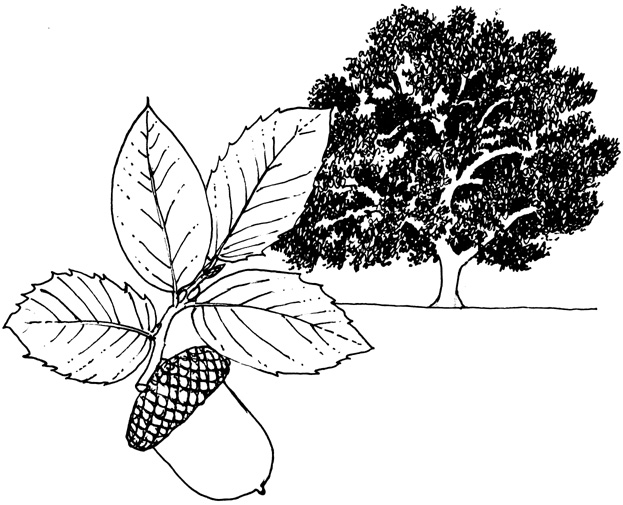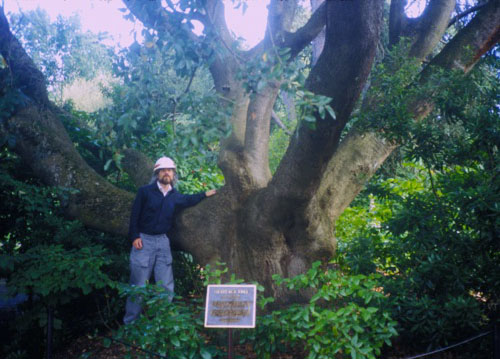Plant of the Month: September 2004
|
Canyon Live Oak
|
Quercus chrysolepis Liebman
|
FAGACEÆ; Beech Family
|
| More than 500 species of Quercus exist, including many evergreen ones. The Canyon Live Oak is from SW Oregon, California and the Southwest. It is the most variable western North American oak in its size, leaf and acorn. Its leaf undersides are more or less gold-tinted, especially when young; and its acorn cups are strongly gold, hence the 1854 name chrysolepis: from the Greek chryso (golden) and lepis (a scale). |
| The name Canyon Live Oak signifies that it is the evergreen (i.e., live) oak that grows largest in the canyons of California's coast mountain ranges. It is also called Goldcup oak because of the acorn cups. The names Iron Oak and Maul Oak refer to its wood. The hard and heavy wood was used to make maul heads. In his 1923 book A Manual of the Vascular Plants of California, Willis Linn Jepson wrote "It furnishes the most valuable wood amongst our species, being strong, tough and close-grained." (page 275). The wood weighs more than that of most oaks, 54 pounds per cubic foot. |
| Though it has been sold by California nurseries since at least 1871, it is not commonly cultivated for ornamental usage there. Where I live, in western Washington, it has been grown sparingly since at least the 1940s. Here it grows extraordinarily fast. I guess that this is because more rainfall occurs here, and the planted, isolated trees spend less energy producing acorns, and perhaps trees in the wild are also stunted a bit by galls or witches brooms or the like. |
| In appearance the trees are dark, broad and imposing. The tallest ever recorded was 110 feet (near Ukiah, California before 1910). Charles Sargent reported some 150 feet wide. A trunk in the Angeles National Forest was 36 feet 3 inches in girth in 1944 --more than 11.5 feet thick. |
| John Muir, the famous naturalist, wrote that it "is a tough, rugged mountaineer of a tree, growing bravely and attaining noble dimensions on the roughest earthquake talluses in deep canyons and Yosemite valleys. The trunk is usually short, dividing near the ground into great, wide-spreading limbs, and these again into a multitude of slender sprays, many of them cord-like and drooping to the ground . . . The top of the tree where there is plenty of space is broad and bossy, with a dense covering of shining leaves, making delightful canopies, the complicated system of gray, interlacing, arching branches as seen from beneath being exceedingly rich and picturesque." [From The Mountains of California; 1894; page 225] |
| Its foliage is dense. Each leaf is thick, dark glossy green on top; pale bluish-gold beneath, measuring up to 4 inches long by 2 inches wide, fully evergreen. Some leaves, especially on young vigorous shoots, are holly-like; others are wholly untoothed. The acorns, ripe in September or October, are usually an inch or two long but can be either smaller or immense --the largest in California. The acorn cups are shallow and golden. |
| Seattle boasts a specimen of special importance at the Carl S. English, Jr. Botanical Garden, in the Ballard neighborhood. The English Garden is the 7.5 acre public garden adjacent to the Hiram M. Chittenden Locks and fish ladder, on the Lake Washington Ship Canal, managed by the Seattle District of the U.S. Army Corps of Engineers. The locks were built between 1911 and 1917. From 1931 until 1974 the horticulturist responsible for the development of the garden was Carl S. English, Jr. (1904-1976). Thanks largely to English's efforts, and to his successor Michael Fleming, the variety of trees present is amazing. People from far and near come to admire the beautiful, diverse plantings. |
| The giant Canyon Live Oak at the locks, west of the Administration Building, was dedicated as a Seattle Heritage Tree on October 13 2001. John Dixon nominated it for the Heritage status. A bronze plaque was unveiled at a ceremony. The plaque stated something along these lines: "PlantAmnesty is proud to acknowledge this splendid example, the first evergreen oak Seattle Heritage Tree. It is likely as old as any in the city, arguably the fastest growing, as healthy as can be, and certainly the largest of all. Millions of visitors to the locks and gardens have strolled beneath its magnificently broad crown." |
| The Heritage specimen had been measured in 1989 at 51 feet tall, 57 feet wide, its trunk 8 feet 1 inch in circumference. By 2003 it had grown to 56 feet tall, 78 feet wide, its trunk 11 feet 6 inches around! But then on July 8th 2004 about a quarter of the tree crown broke and fell. Ever since the tree has been roped off and various experts have weighed in with their opinions as to its safety. The consensus is that it grew too fast for its own good. The hazard can be mitigated by reducing its growth rate by ceasing to water it. But its crown of branches also needs to be lightened carefully, braced and cabled. Annual monitoring is necessary. (It was removed in July 2005, right after the photo below was taken.) |
| Other specimens of Canyon Live Oak are at the locks in these beds: 5 (shrub-sized), 23 (two), 29 (by lightpost), 120 (small), 208, 210 (the largest tree in the bed) and 323 (a bush). In addition, the former home of Carl English has it: 8546 30th Avenue NW. Seattle's Washington Park Arboretum has some, as does the U.W. campus. |
The illustration below, drawn by Michael C. Lee, and used with permission, is from a yearly catalog of Colvos Creek nursery. Colvos Creek nursery sells many of the rarer species found at the locks, including this oak. For more information write to PO Box 1512, Vashon Island, WA 98070, or telephone (206) 749-9508, or go to the website http://www.ColvosCreekNursery.com.
Back
|

Quercus chrysolepis drawing by Michael C. Lee
|

Quercus chrysolepis and ALJ at Locks; photo by Brian Carter
|
|
|

